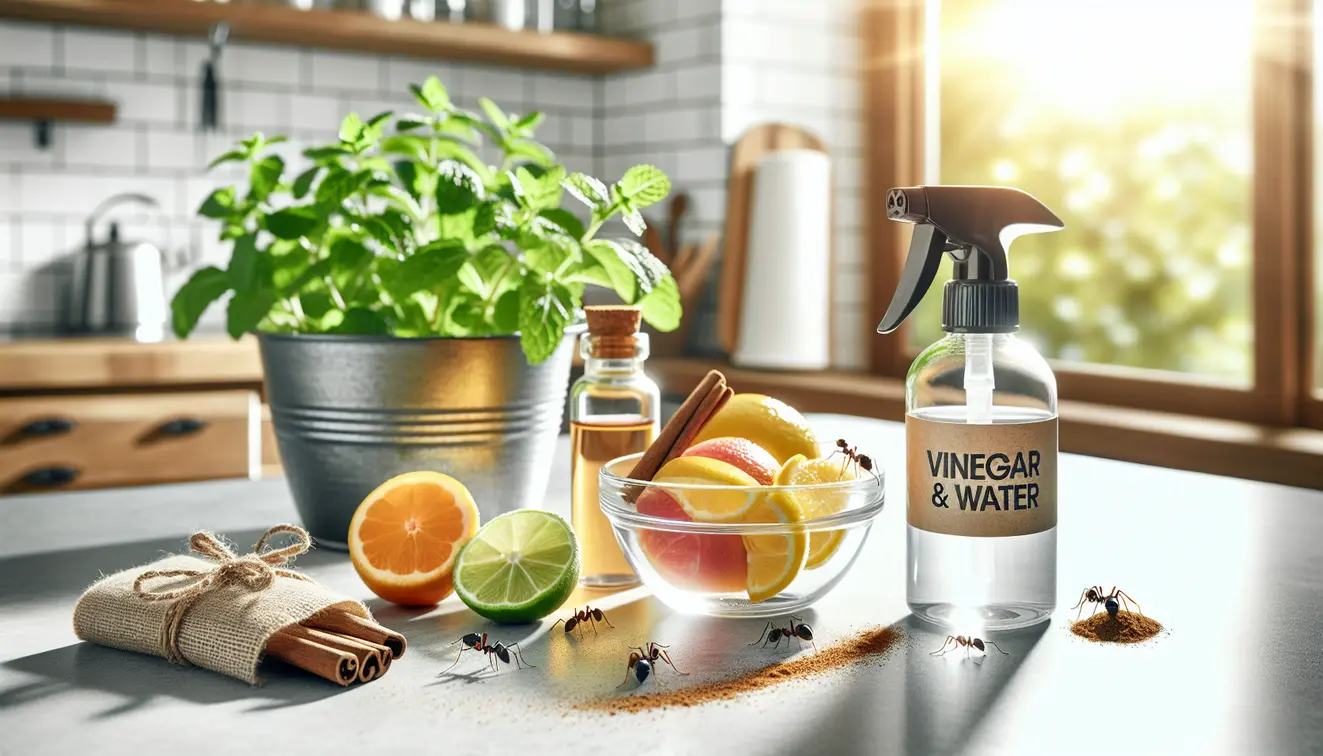Home Remedies for Ants in the House: Safe and Natural Solutions for 2025
Estimated reading time: 10 minutes
Key Takeaways
- Natural remedies like vinegar, essential oils, and citrus can effectively repel ants without harmful chemicals.
- Identifying ant attractants such as food crumbs and moisture is crucial for prevention.
- Safe application indoors requires caution near pets, children, and food areas.
- Consistency in prevention—like sealing entry points—keeps ants out long-term.
- For stubborn infestations, eco-friendly professional help may be necessary.
Table of Contents
- Introduction to Indoor Ant Problems
- Why Ants Invade Your Home
- Types of Ants Found Indoors
- Top 10 Natural Home Remedies for Ants Indoors
- How to Apply Natural Remedies Safely Indoors
- Long-Term Prevention Tips for an Ant-Free Home
- The Science and Tradition Behind Natural Ant Remedies
- When to Call for Professional Help
- Frequently Asked Questions (FAQs) About Natural Ant Remedies
- Additional Resources and Tools for Ant Control
Introduction to Indoor Ant Problems
Dealing with ants in your home can feel like an endless battle. Their tiny trails across countertops or sudden appearances near food spark frustration for many of us. At Wiki Home Remedies, we understand how unsettling it is to share your space with these persistent invaders.
This guide focuses on natural, non-toxic solutions to keep your home safe for family and pets. Chemical pesticides often carry risks to health and the environment, as noted by sources like the Environmental Protection Agency. Instead, we’ll explore remedies that harness nature’s power without harmful side effects.
You’ll find practical steps in this article, from simple home treatments to prevention ideas. We’ve gathered insights grounded in real experience and reputable research to help you reclaim your space. Let’s dive into understanding why ants invade homes and how to stop them naturally. For more natural solutions to common household issues, check out our guide on pet-safe remedies.
Why Ants Invade Your Home
Ants don’t wander into your house by chance; they’re drawn by specific needs. These tiny creatures seek food, water, and shelter, often finding all three in our living spaces. Recognizing what lures them in is the first step to keeping them out.
Homes offer endless temptations for ants, especially in kitchens or dining areas. Sugary spills, unsecured snacks, or even a damp sink can signal a feast. Once they locate a source, they leave scent trails for others to follow, turning a small sighting into a full invasion.
Understanding their behavior helps you tackle the root of the problem. By removing attractants, you disrupt their mission before they settle in. Let’s look closer at what specifically pulls ants into your home.
Common Attractants in Homes
- Crumbs or food residue on counters and floors act as an open invitation.
- Unsealed containers of sugar, honey, or cereal draw ants with their sweetness.
- Pet food bowls left out overnight become easy targets for hungry ants.
- Leaky pipes or standing water near sinks provide the moisture they crave.
- Cluttered pantries hide spills or forgotten snacks, creating hidden buffets.
Breaking this cycle of attraction sets the stage for effective natural solutions. Next, let’s identify which ants you might be dealing with indoors. If you’re also dealing with pet-related pest issues, such as fleas, visit natural solutions for dog ear mites.
Types of Ants Found Indoors
Not all ants are the same, and knowing which type invades your home matters. Different species have unique habits, and remedies may work better for some than others. Let’s explore a few common indoor ants you’re likely to encounter.
Argentine ants, small and brownish, often form long trails seeking sweets or grease. Carpenter ants, larger and black, pose a bigger threat by nesting in wood, potentially harming structures. Then there are odorous house ants, tiny and dark, emitting a peculiar smell when crushed, usually foraging near moisture.
Identifying the ant type helps tailor your natural approach for better results. For instance, scent-based deterrents might work well on Argentine ants but less on carpenter ants. With this in mind, let’s move to specific remedies to send them packing.
Top 10 Natural Home Remedies for Ants Indoors
You don’t need harsh chemicals to reclaim your home from ants. Nature offers plenty of solutions that are both safe and effective when used correctly. Below, we’ve curated ten remedies using everyday items or natural ingredients, complete with steps to apply them indoors.
Each method considers safety for your household while targeting ants at their source. Let’s walk through these options so you can choose what fits your needs best.
Vinegar and Water Spray
Vinegar disrupts the scent trails ants rely on to navigate. Mix equal parts white vinegar and water in a spray bottle. Spritz along entry points like windowsills or door frames where you spot trails.
- Shake the mixture before each use to blend it well.
- Wipe surfaces after spraying to avoid sticky residue.
- Repeat daily until ants disappear.
Keep this away from delicate surfaces; vinegar can be harsh on some finishes.
Peppermint Essential Oil
Peppermint’s strong aroma repels ants naturally, as supported by natural health insights. Dilute 10-15 drops of pure peppermint oil in a cup of water. Spray or dab it with cotton balls near ant paths or entry spots.
- Always dilute to prevent skin irritation.
- Place soaked cotton balls in corners ants frequent.
- Refresh every few days for ongoing effect.
Ensure good airflow when using strong scents like this indoors.
Lemon Juice or Citrus Peels
Lemon’s sharp scent deters ants from crossing treated areas. Squeeze fresh lemon juice or rub citrus peels near entryways and counter edges. Leave peels in problem spots overnight if possible.
- Use fresh juice or peels for the strongest impact.
- Clean up residue to avoid attracting other pests.
- Replace peels every couple of days.
This method works well near food zones since it’s entirely safe to ingest.
Diatomaceous Earth (Food-Grade)
This fine powder dehydrates ants on contact, safe for indoors if food-grade. Sprinkle a thin layer in hidden spots like behind appliances or under cabinets. Avoid heavy dusting to prevent inhaling particles.
- Wear a mask while applying to stay safe.
- Keep away from pet or child reach.
- Vacuum after a few days to clean up.
Focus on dry areas, as moisture reduces its impact over time.
Cinnamon (Ground or Oil)
Cinnamon’s scent confuses ants, steering them away from treated zones. Sprinkle ground cinnamon or dilute cinnamon oil with water near entry points. A light dusting along baseboards works too.
- Use a small amount to avoid mess.
- Mix oil with water for a safer spray.
- Reapply after cleaning or sweeping.
It doubles as a pleasant scent for your home while repelling pests.
Borax and Sugar Bait
Borax mixed with sugar attracts ants, then harms them in small doses. Combine one part borax with three parts sugar, adding a little water to form a paste. Place in shallow lids away from kids and pets.
- Position near ant trails but out of reach.
- Monitor and refill bait as needed.
- Clean spills to prevent accidental ingestion.
Use sparingly; it’s effective but requires careful placement indoors.
Tea Tree Essential Oil
Tea tree oil’s potent smell pushes ants away without toxins. Mix 10 drops with a cup of water in a spray bottle. Apply lightly to ant-prone areas or soak cotton balls for corners.
- Never use undiluted on skin or surfaces.
- Ventilate rooms during application.
- Replace soaked cotton every few days.
It’s a strong option, so test small areas for scent tolerance first.
Coffee Grounds
Used coffee grounds disrupt ant trails with their lingering aroma. Spread damp grounds near entry points or mix with soil in indoor plant pots. They’re an eco-friendly way to repurpose waste.
- Ensure grounds are cool before use.
- Place in small piles near problem spots.
- Swap out every few days to stay fresh.
This works best alongside other methods for stronger impact.
Chalk or Baby Powder Lines
Drawing lines with chalk or baby powder creates a barrier ants avoid. Sketch lines at doorways or sprinkle powder along windowsills where ants enter. It’s a simple, no-mess trick.
- Redraw lines after foot traffic or cleaning.
- Use non-toxic powder if opting for talc.
- Check for disruption after rain or drafts.
It’s temporary but useful for quick defense in high-traffic zones.
Baking Soda and Sugar Mix
This mix draws ants in, then disturbs their system internally. Blend equal parts baking soda and sugar, placing small amounts near trails in safe containers. Keep it far from food prep areas.
- Use lids or jars to contain the mix.
- Check daily for ant activity nearby.
- Dispose of leftovers after a week.
It’s subtle but needs patience to see ants dwindle over time.
How to Apply Natural Remedies Safely Indoors
Using natural remedies keeps your home free of harsh chemicals, but caution still matters. Many of these solutions are safe by nature, yet they require mindful handling near food, children, or pets. Let’s ensure you apply them without worry.
Always test mixtures on small, hidden spots to avoid surface damage. For sprays with strong scents like essential oils, open windows to maintain fresh air. Store homemade solutions in labeled containers, out of reach from curious hands or paws, referencing safety tips from sources like the ASPCA.
Consider where you place baits or powders; avoid food prep zones entirely. If using sticky or powdery substances, lay down protective sheets to shield floors or furniture. By following these steps, you keep the process safe and effective for everyone at home. Curious about natural remedies for pet health issues? Explore more at natural remedies for dog yeast infections.
Long-Term Prevention Tips for an Ant-Free Home
Getting rid of ants now is only half the battle; keeping them out lasts longer. Prevention starts with breaking the cycle of attraction in your home. Small, consistent habits can make your space less inviting to these tiny intruders.
Start with cleanliness as your foundation. Store food in sealed containers and wipe surfaces after meals to remove crumbs or spills. Don’t let pet bowls sit out overnight with uneaten food beckoning ants.
Beyond tidying, seal physical gaps where ants sneak in. Check windows, doors, and baseboards for cracks, filling them with silicone caulk or natural putty. A tight home is a tough target for any pest seeking shelter.
Finally, embrace ongoing deterrents. Place mint plants near windows or wipe counters with vinegar solution weekly. Tidy outdoor areas too—clear yard debris or trim plants touching walls to cut off easy entry routes. Routine checks of common spots like kitchens or bathrooms help catch issues early.
The Science and Tradition Behind Natural Ant Remedies
Natural remedies aren’t just old folk tricks; many have roots in science. Vinegar, for instance, erases scent trails ants follow, disrupting their navigation as noted in pest behavior studies. Essential oils like peppermint overwhelm their senses, pushing them to retreat from treated spaces.
Tradition also plays a role across cultures. Cinnamon and citrus peels have long been used in homes worldwide to ward off pests, valued for their strong aromas. These methods weave history with practicality, offering solutions passed down through generations.
Keep in mind that results can vary. Some ant species respond differently, and severe infestations might resist natural options alone. Trust these approaches for mild issues, but stay open to further steps if challenges persist.
When to Call for Professional Help
Sometimes, natural remedies reach their limit, and that’s okay. If you spot visible nests inside walls or notice wood damage from species like carpenter ants, it’s time for expert aid. Large colonies often signal a deeper issue beyond DIY scope.
Seek eco-friendly pest control services that prioritize non-toxic methods. Many professionals now offer green solutions aligned with natural health values. Check local directories or online reviews to find trusted providers near you.
Your household’s safety comes first. If ants return despite consistent efforts or bites become a concern, don’t hesitate to call in help. Balancing natural attempts with professional support ensures peace of mind in stubborn cases.
Frequently Asked Questions (FAQs) About Natural Ant Remedies
Questions often linger when trying new approaches to pest control. We’ve gathered common concerns to ease your mind and guide your natural journey against ants.
Are natural remedies safe for all pets?
Most are, like vinegar or citrus, but some, like essential oils, need caution. Check with resources like the ASPCA for specifics on oils or borax near animals. Always keep baits out of pet reach.
How long do these remedies take to work?
It varies—scent disruptors like vinegar act fast, while baits like borax may take days. Patience and repeat applications often yield the best outcome.
Can I combine multiple remedies for better results?
Yes, layering methods like sprays and barriers can boost impact. Just avoid mixing strong substances without testing to prevent odd reactions.
What if ants keep coming back after treatment?
Reassess attractants or entry points. Tighten prevention and consider professional help if numbers don’t drop.
Are there natural remedies for specific ant types?
Some work broadly, but carpenter ants may need targeted baits over simple repellents. Match the method to the behavior you observe.
Additional Resources and Tools for Ant Control
Your journey to an ant-free home doesn’t end here. Wiki Home Remedies offers extra support to keep you equipped against pests. Dive into these tools for deeper insight and practical help.
We’ve crafted a printable checklist of remedies and prevention steps from this guide. Download it to track your progress easily at home. For broader reading, explore pest control sections on trusted sites like the EPA or NIH for natural strategies.
Curious about tackling other insects naturally? Check related articles on our site, such as guides to non-toxic pest control for spiders or flies. For pet owners dealing with pest issues, see our article on natural solutions for fleas. Additionally, learn more about safe remedies for pet skin irritations at home remedies for dog scratching. These resources, paired with what you’ve learned, empower you to maintain a safe, inviting home in 2025 and beyond.










